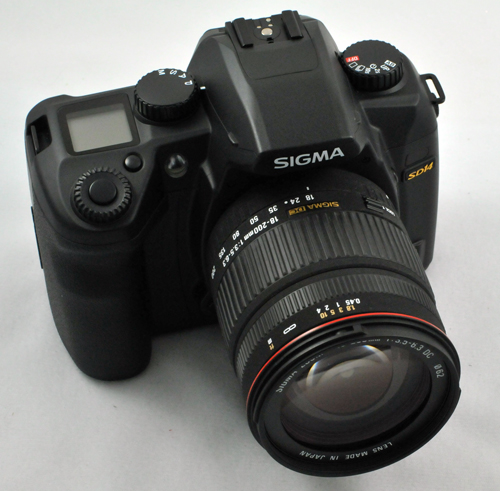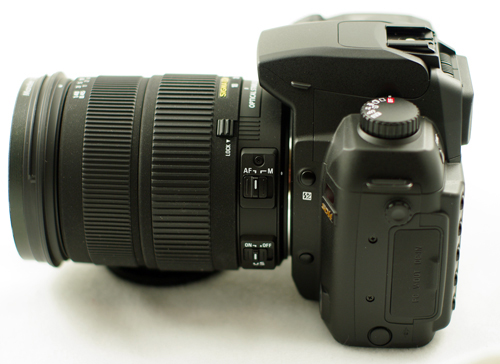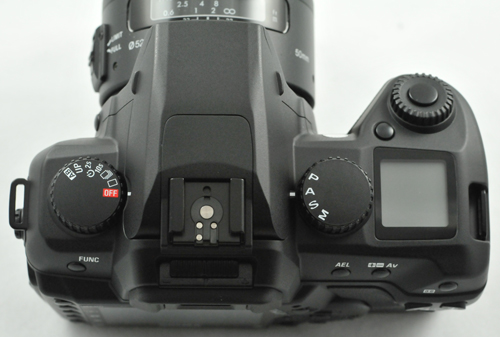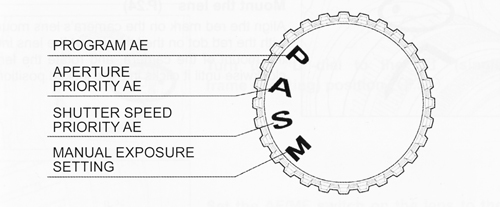Sigma SD14: Quick Look at a Quirky Wonder
by Wesley Fink on June 3, 2008 4:20 AM EST- Posted in
- Digital Camera
Operation and Controls

The Sigma SD14 is a medium-sized camera. It is much larger than the tiny Canon XSi/XTi or the Nikon D60/D40. Compared to prosumer modes, it is about the same width as the Nikon D300 or Canon D40 but not quite as tall. Here it is fitted with the non-OS version of the Sigma 18-200mm f3.5-6.3, which is one of the smallest super-zooms we have seen on the market. The SD14 appears well built, and Sigma states it is built around a stainless-steel frame.

The lens release lock is on the left facing the camera, and you can see the depth of field preview button on the right side of the mount in this view. The top button is the flash compensation button, used with the dial around the shutter release to adjust the output of the pop-up flash. In this view the SD14 is mounted with the larger 18-200mm f3.5-6.3 OS lens.

The SD14 features a simple menu and controls. The ISO/WB button just above the arrow pad brings up a screen to adjust ISO, White Balance, Quality (RAW, JPEG), and Resolution (Image Size). The menu itself does not even need sub-categories and all the adjustments fill just three screens of information on a single menu. The only thing that does not fit this simple approach is the strange FUNC button to the left of the viewfinder that brings up eight additional functions (in the latest firmware versions) adjusted by selecting the function, holding in the FUNC button and rotating the front dial.

The top has a dial on each side plus a small LCD screen. The LCD screen reports basic info such as frame and battery status. It is also used with many of the buttons and the dial around the shutter button to adjust less frequently used options.

For example to enable ISO 1600 you hit the function button six times, then push it a seventh time and hold in the FUNC button. You will see def (default) on the top LCD. Turn the front dial one click while holding the FUNC button until you bring up the ETD (Extended) function in the top LCD. You then have the option of ISO 1600 added to the ISO options. It is really easier than it sounds, and with the firmware version 1.05 and later you have an ISO 50 option as well.

The top left dial is called the Drive Dial and it is unusual in that it is also used to turn the SD14 on and off. You can also select drive mode, one of two self-timer modes, mirror lock-up, and auto bracketing.

The top right Mode Dial could not be simpler. You can select Program, Aperture Priority, Shutter Priority, or Manual. That's it as there are no scene modes. Metering is selectable from a top rear button for spot, center-weighted, or the default 8-segment matrix.
Sigma SD14 marketing materials make a huge deal out of how simple the SD14 is as a camera. In general that is certainly true, but we have to wonder if that is the case because Sigma didn't have the internal resources to build anything more sophisticated. After using the slow SD14 you will understand exactly what is being said here.
You can do almost anything you need to take better photographs with the Sigma, and the options are here that are often missing on competing
cameras - like mirror lock-up, 2s self-timer option, illuminated top LCD, and selectable metering. However, you can't
do anything fast, since the internal processing and write times are extremely slow. Once we changed to a CF card that was a better match to the SD14 the camera was ready to use about a second after turning it on - that is certainly acceptable.
However, in shooting the RAW images for
the noise comparison on the next page it was 2 to 3 seconds of solid red just to do enough
to display the image on the rear 2.5" LCD, then about 6 seconds more of blinking
to write the 13.3MB RAW file. If you choose JPEG processing it takes even longer than
RAW. In fairness it is possible to take another picture while the camera is writing, but the processing speeds are slow and the small buffer can only hold about 6 images before forcing a wait for write. The result is that capturing images with the SD14 is a slower process than with competing cameras.
However, there is more to this than just the slow processing speeds of the SD14. No one but Sigma had the guts to try to build a Foveon-sensor camera. In fact Sigma has just introduced another Foveon-sensor camera - the first DSLR-sensor point-and-shoot - in the Sigma DP1. If you are ready to ask, "why did they bother?", we hope to show you on the next two pages.










40 Comments
View All Comments
justascot - Wednesday, June 4, 2008 - link
Pinto if you are genuinely looking for an extra tool to complement the 5d that you already own then you may well be interested to read a comparison between the 5D and the SD14 as carried out by another user as found here http://www.ddisoftware.com/sd14-5d/">http://www.ddisoftware.com/sd14-5d/Personally I find Image quality to be a subjective thing. I own the SD14 myself and enjoy it but I would never try and suggest that it is always going to be a better camera than your 5D. Your 5D is capable of working in different areas than the SD14 but you may well find on occasions (if you like the IQ of the foveon look that is) that you will prefer to use the SD14 for certain subject matters but that depends on 3 factors - your shooting style, your photographic interests and your ability to see the difference between the foveon and the bayer image and most importantly that like what you see.
I'm not going to try and sell you a SD14 that should be Sigma's job, I just see the camera (whoever manufacturers it) as a tool in which to do a job. I happen to like the end result of what this tool is capable of in the areas that I have in interest in - that being landscapes, portraiture and IR. Having used this camera for a few months now and seen the images of other users I am also gaining more of an interest in macro. These are all areas in which the SD14 excels if you have an interest in any of those fields it might well be worthy of further consideration by yourself.
As for the Megapixels argument, I have little time for that between any manufacturer. The quality of the megapixels seems to vary greatly between camera and camera no matter whether a foveon or bayer chip is used. I know from experience that there is a lot of information in a raw foveon image that suggests it is greater than the 4.7MP that some say, but less than the 14MP that Sigma would like us to believe. There are some users that say they can get print up to A0 with a SD14 file, and Sigma have been known to do this themselves but personally I've never felt the need to print that extreme. A2, or perhaps on the rare occasion A1 would be perfectly adequate for my needs and for that the raw file of the SD14 is ideal. It takes a little bit of skill to get the most of the foveon file. In my experience I found the auto white balance wasn't good enough for my needs but after switching to custom white balance in camera I found the results improved dramatically.
My advise is to do your research and look at what others who own the SD14 are able to get out of it and decide from there. In the end that's what sold it for me. The cheap price although a factor in sparking my initial interest was also something that put me off to an extent but it was the photography of the long term users that persuaded me in the end not the marketing by Sigma or megapixels argument between bayer or foveon fans.
pinto4402 - Wednesday, June 4, 2008 - link
Your comments are well taken. Thank you for taking the time discuss this with me.justascot - Wednesday, June 4, 2008 - link
You are welcome. I hope whatever conclusion you come to, it proves to be the right decision for you.My apologies for my lack of spacing between paragraphs in my previous comment I hadn't realised my mistake until after I pressed send.
Wesley Fink - Tuesday, June 3, 2008 - link
WE WERE WRONG ABOUT START-UP.We used three different 8GB CF cards in the course of testing fro this review. All were 280X cards based on Samsung memory chips, and all 3 cards have worked fine with every other camera we have tested at AT.
After receiving several emails from SD14 users reporting startups of 1 second or so we tried two new CF cards of different brands - a 16GB and a 4GB. BOTH the new cards initialized in about a second and we have not experienced a lock-up yet in shooting with either card. THE STARTUP DELAY AND LOCK-UPS APPEAR TO BE THE FAULT OF CF CARD COMPATIBILITY ISSUES AND NOT THE SD!$ CAMERA.
We will revise the review shortly to reflect these findings and also update the lock-up issue as soon as we have had more time with the new cards.
justascot - Tuesday, June 3, 2008 - link
By on large as a Sigma SD14 owner of a few months I found this a fair and reasonable review, except on one matter. The experienced start up time of the author of this review puzzles me greatly. When I turn on my camera, within about a second its ready to go. If I had experienced an 8 second start up time I would have returned it to the shop in frustration. Sadly I'm not patient enough to deal with a start up time of that magnitude, thankfully I've not had to do just that. In fact the start up time has never been an issue for me. I'm not sure why the author experienced this issue, perhaps it was the 15 year old lens that was used although that seems unlikely.There are areas where the camera is slow, writing to card for instance - so for someone who is used to a quicker camera it does mean an adjustment in shooting styles.
Anyway about from the issue I highlighted it was a fair review. The Image quality of the camera is superb with good quality lens when combined with good skills of an experienced photographer. I would say the IQ compares favourably with the mid priced dslrs albeit at low isos, and with the current price of the SD14 it is a bargain, especially when you consider you have two cameras for the price of one if you are into IR. Most if not all other Dslrs require a permanent irreversible modification if you want to shoot in IR, whereas with the SD14 you can easily swap between regular colour and IR as your mood dictates.
I would never try to suggest this as a camera for everyone, its a specialist camera but if you have an interest in Landscape, Macro, portraiture and/or Infrared photography its well worth consideration for the image quality capabilities of the camera and the price - and unless something is very wrong it should be ready to shoot without contemplating whistling the first few notes of "Why are we waiting...."
Souka - Tuesday, June 3, 2008 - link
9 sec start up time? Probably running a flavor of Windows....crimson117 - Tuesday, June 3, 2008 - link
This is hardly primitive gear. As Wesley wrote in the review, since no other major manufacturer has used the Foveon sensor, it's impossible to know whether it's the camera design or just the sensor itself that is responsible for the slow response times.Your portrait photographer friends don't need a really quick camera, as portraits are usually carefully set up and controlled. Add in unbeatable image quality and it sounds like the right choice for a portrait photographer.
aeternitas - Tuesday, June 3, 2008 - link
Layer-per-primary is the future of digital photography. I can't wait till Canon or Nikon do the same, as they are bound to wrap more accurate hardware around the technology.For more pictures
http://reviews.photographyreview.com/blog/sigma-sd...">http://reviews.photographyreview.com/blog/sigma-sd...
s12033722 - Wednesday, June 4, 2008 - link
Layer-per-primary is definitely NOT the future of digital photography. It's a concept that sounds nice, but in practical application things are a lot muddier. The basic problem is that while the literature makes it sound like red photons go to one layer, green to another layer, etc, the reality is that you don't get nice discretely separated layers. Photons of a certain wavelength will generally penetrate silicon to a certain depth, but that depth varies based on a lot of factors, and photons come in a continous spectrum, not discretely separated wavelengths, so the reality is that you get a nice soup of photons all being absorbed in the "red" layer that may not be red at all. The sigma cameras are only able to produce their images through some very impressive image processing.If you want R, G, and B information at each pixel, there is a good way to do it: 3-CCD technology. Use a beamsplitter to image the same scene with 3 different imagers each filtered for one color. That will give you correct tri-color information at each pixel, but it costs a lot and it can be quite difficult to design.
Justin Case - Friday, June 6, 2008 - link
And has no real advantage over a single Bayer sensor with twice the height and width. Takes up (a lot) more space, cost more and is extremely hard to align (different wavelengths diffract differently).